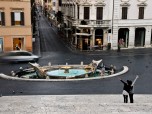
basilica of Santa Maria degil Angeli e dei Martiri inside the baths
Photo by: Panairjdde Creative Commons
The Baths of Diocletian were the most impressive of the public baths in Ancient Rome. Opened in 306 AD, they were used for more than two centuries before the water supply was cut off by the Goths. They are similar in structure and layout to many other Roman baths, being distinguished chiefly by their immense size. Today, the remains of the baths have become a major tourist attraction.
Background
It was Diocletian’s co-emperor, Maximian, who was responsible for commissioning the baths in 298 AD. After he and Diocletian had abdicated, the new emperor Constantius continued the project. It is thought that the emperor’s main reason for having the baths built was to outshine the Baths of Caracalla, which by that time were almost a century old. The new baths had a capacity twice as large as Caracalla’s structure.
As with most large Roman bath complexes, Diocletian’s consisted not only of the baths themselves but also a variety of libraries, gymnasiums, theaters, gardens, and other public spaces. There were pools of cold, tepid, and hot water, and the floors were decorated with fine mosaics. Marble was used extensively in the baths’ interior construction, although the exterior was made of stucco fashioned to look like marble. The central hall, which was of great size, became the model for the Basilica of Maxentius.
Location
The baths were built on the top of the lowest of Rome’s seven hills, the Viminal, close to the Servian Wall. They were therefore convenient for use by inhabitants of the Esquiline and Quirinal quarters of Rome. The site had formerly been the location of a second-century monument named the Quadrigae Pisonis.
The baths’ water supply came from the aqueduct known as the Aqua Marcia, which by that time had been in operation for close to 200 years. Because of the sheer volume of water that would be required for his new complex, Diocletian gave an order that the overall level of water supply to Rome should be significantly increased. Some historians believe that the baths were additionally supplied by a second aqueduct, the Aqua Antoniniana.
Bathing
The baths consisted of three main parts: the caldarium, tepidarium, and frigidarium. The first of these was a hot room, which contained a hypocaust providing heat from beneath the flooring. This was powered by a furnace burning wood, which was operated by specialized slave labor. Similar rooms were provided for each gender. The caldarium contained a sunken bath which was filled with hot water, as well as a drier area where patrons would work up a sweat, add olive oil to their bodies, and then use a curved tool called a strigil to scrape away dirt.
In the tepidarium, a somewhat lower level of heat was provided by the hypocaust. This was situated in the large entrance hall, which had sufficient natural light to allow the installation of rich, complex decorative work.
Finally, the frigidarium contained a cold pool in which patrons would soak in order to close the pores of their skin, having had them opened by the hotter rooms they had visited beforehand. Some authorities suggest that, after the conversion of the empire to Christianity in the fourth century, the pool may have been used to baptize converts.
Later History
The Baths of Diocletian were popular with Roman citizens and they remained in continuous use for more than two centuries. The baths might have continued in operation for longer had it not been for the invasion of the Goths in the sixth century. In 537, these invaders cut off the water supply that fed Rome’s hundreds of baths.
One part of a partition from the Roman complex survives in the facade of the Basilica Santa Maria, while the Museo Nazionale Romano is now located in the complex’s great hall. This museum was opened in 1889 with the goal of preserving and displaying works of Ancient Roman art. Religious concerts take place at the baths during Easter and Christmas. The baths are also the location for many state funerals.




































